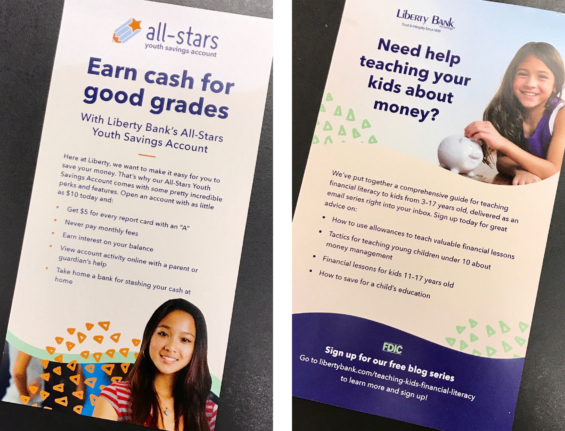Catering to kids is often seen as a vestige of old-fashioned banking — a quaint throwback to less competitive times when financial institutions could afford to subsidize family-friendly accounts in exchange for the goodwill generated.
The very premise of a children’s program has become suspect among banking executives today. Holding on to a checking or savings relationship for 20 or 30 years until little Johnny grows up to finally reach financial maturity is unlikely, since Millennials are already more apt than any generation to switch banking providers. That trend will surely continue, if not accelerate.
But with a few modifications, your young saver program can be turned into a powerful and profitable acquisition tool.
A year ago, Liberty Bank in Chicago took a hard look at its All-Star Youth savings program… and it wasn’t pretty — declining accounts, small balances, 1950s-style graphics, and a plush animal “rewards program” linked to deposit size. An upgrade was overdue and sorely needed.
As a broad goal, the bank wanted a program that was more relevant to a contemporary urban lifestyle — specifically Millennial families. But it also had to be profitable and generate new accounts.
Internal research turned up three interesting facts:
(1) The balances custodians held in bank accounts was six times larger than the total in their children’s account. The average balance in a CD, for instance, is $34,000.
(2) Parents really liked an account feature which awarded students $5 for each “A” grade they got on their report card.
(3) Parents want help teaching their children money management skills. Parents just aren’t comfortable with this subject (after all, how much do they really know themselves?). Surveys reveal they are more comfortable talking about bullying, drugs and smoking than finances or investing.

The Financial Brand Forum Kicks Off May 20th
Explore the big ideas, new innovations and latest trends reshaping banking at The Financial Brand Forum. Will you be there? Don't get left behind.
Read More about The Financial Brand Forum Kicks Off May 20th

Move the Needle from Attrition to Acquisition
Vericast’s 2024 Financial TrendWatch explores seven of today’s most critical financial services trends to provide a complete view of the current loyalty landscape.
Read More about Move the Needle from Attrition to Acquisition
These observations helped Liberty Bank to reimagine their All-Star program, shifting from a product aimed at purely at children to one based on promoting financial literacy and academic achievement that primarily targeted parents. The bank took this sleepy, poorly conceived account and put it on the path to become a profitable tool for acquisition and retention.
The new positioning illustrated Liberty’s community focus, strengthened relationships and brought families into the bank regularly through the ‘A grade’ feature.
To help parents teach money management skills, Liberty Bank prepared original website content focusing on two audiences: children under ten years of age, and those between the ages of 11-17. Content includes articles, infographics and landing pages. Liberty Bank also created a blog for parents on teaching money management skills.
Qualifying for an All-Star Account is easy. The interest-bearing account can be opened with as little as $10, requiring no minimum balance or monthly fee. Passbooks are given to help children track their savings; with their parent’s permission, there’s also an online option.
To get them on the right path, each new account comes with a piggy bank. The deposit “rewards program” was discontinued, and the old-fashioned graphics updated to a more contemporary look.
As with many community banks, Liberty has an older customer base and has had limited success in appealing to Millennials. However, Liberty Bank leverages the All-Star program as a popular acquisition tool for reaching young, growing families, even those who might have accounts elsewhere.
The rejuvenated All-Star program kicked off with digital ads highlighting the “$5-for-an-A” program that were placed on local news and parenting websites. Liberty Bank also used paid search, sponsored content and digital remarketing.
Liberty Bank’s community development team dropped collateral material off at neighborhood schools and school functions where the bank had been building relationships. Liberty Bank also customized email appeals to parents and grandparents in its customer base. Brochures targeting parents and grandparents were — and continue to be — distributed at regular activities and family events sponsored by the bank.
The program relaunch didn’t get the typical splash associated with a major retail campaign, but this product is being taken very seriously, and has been incorporated into ongoing cross-marketing efforts. Liberty Bank also launched an onboarding program to systematically market products to children and parents based on whatever is appropriate for their age.
Results have been encouraging. The first three months of the new program turned around three years of declining numbers for this product line. All-Star account openings have jumped 35%, and — more importantly — the rate of new custodian accounts has doubled. Thousands of visitors have clicked on the All-Star landing page, and hundreds are browsing the bank’s new library of financial literacy content.
Beyond simply updating a children’s savings account, the program found that families want to raise financially responsible children and community banks are ideally positioned to help them achieve that goal, and in the process, attract a desirable audience that’s hard-to-reach.








